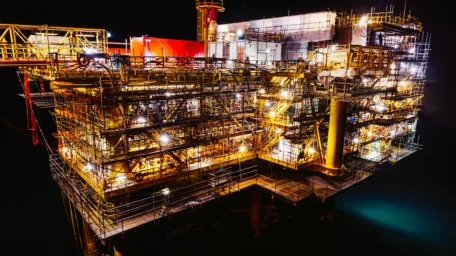Situated at the forefront of an epochal shift, industry leaders hold the potential to profoundly alter the energy efficiency landscape within the oil and gas sector. Their decisions carry the power to create a ripple effect throughout the industry, balancing the scales between environmental responsibility and business profitability. How? By daring to invest in low-carbon technologies, they can noticeably shrink their carbon footprint without sacrificing financial performance.
By adopting large-scale emissions reduction initiatives, they have the ability to enhance both operational efficiency and capital discipline. Diversifying their energy sources, particularly towards low-carbon alternatives, could also manifest as a significant move towards sustainability. But the change doesn’t end there. By advocating for astute policies that effectively cost carbon, they help weave the fabric of responsible industry practices.
The implementation of carbon capture and storage (CCS) technology and other decarbonisation strategies would also add to their arsenal in combating climate change. These proactive steps could dramatically curtail emissions, optimise costs, and underpin the industry’s longevity. Hence, industry leaders stand at the precipice of change, poised to define the sustainable future of the oil and gas sector.
Table of Contents
- How Can Capital Investment In Low Carbon Technologies Benefit The Oil And Gas Industry
- How Can Existing Digital Oilfield Infrastructure Help With Carbon Footprint Reduction?
- What Are The Benefits Of Modular Design For Oil And Gas Facilities
- What Are Some Examples Of Energy Efficient Best Practices In The Oil And Gas Sector
- What Operational Risks And Issues Should Be Considered When Introducing New Energy Efficient Technologies
- How Can Oil And Gas Companies Cut Costs With Innovative Data Acquisition And Management Strategies
- What Are Key Metrics Used To Assess The Maturity Of Energy Efficient Technologies
- What Are The Global Trends In End-User Energy Spending And Carbon Emissions In The Oil And Gas Sector
- How Can Self Power And Heat Generation Reduce Oil And Gas Costs
- What Are The Most Effective Ways To Prevent Leaks And Spills In Oil And Gas Operations
- What Are The Benefits Of Upstream Facilities Design To Enhance Energy Efficiency
- How Does Electrification Of Compressors Enhance Efficiency In Oil And Gas Operations
- What Are The Potential Effects Of Replacing Water Injection Pump Impellers On Energy Costs
- What Are The Benefits Of Utilizing Advanced Technologies To Improve The Efficiency Of Liquefied Natural Gas Plants
- What Are The Economic Advantages Of Recycling Heat Output From The Fluid Catalytic Cracking Process
- What Benefits Can Be Derived From Using The Most UpToDate Energy Efficient Equipment
- What Factors Should Be Considered When Evaluating Different Alternatives For Energy Efficient Design
- What Decisions Should Be Used As Drivers For Implementing Sustainable Energy Strategies In Oil And Gas Operations
- What Insights Can Be Gained From Studying Case Studies In Sustainable Energy For The Oil And Gas Sector
- What Steps Can Industry Leaders Take To Reach The International Energy Agencies Targets For The Oil And Gas Industry?
How Can Capital Investment In Low Carbon Technologies Benefit The Oil And Gas Industry
Investing in low-carbon technologies is essential for oil and gas companies to remain competitive in the changing energy landscape. Low-carbon technologies can help companies to reduce their emissions and improve their economic and reputational resilience.
Carbon capture and storage, renewable energy sources, and efficient energy management systems are some of the investments that can be made to reduce emissions and transition to a low-carbon economy. Such investments can also help to reduce operational costs, as well as helping to meet international climate targets.
By investing in low-carbon technologies, oil and gas companies can ensure that they remain a viable part of the energy market for the long term.
How Can Existing Digital Oilfield Infrastructure Help With Carbon Footprint Reduction?
The digital oilfield infrastructure, presents untapped potential in mitigating the carbon footprint of the oil and gas industry. One key way it can do so is through the pioneering use of 3D digital twin modelling. This advanced technique allows for the simulation of oilfield operations, offering a precise visual representation of emission sources. With this technology, we can monitor and track carbon emissions in real-time, enabling companies to identify areas of excess and implement effective measures to reduce output.
Moreover, with the aid of 3D visualisation techniques, digital oilfields can further enhance understanding of emission patterns and, in turn, aid in the development of comprehensive carbon capture and storage strategies. The O&G bespoke software development our company offers is adept at integrating these innovative technologies, creating customised solutions to meet your carbon reduction goals. Our technology-driven approaches not only promote efficiency and productivity in operations, but also facilitate a proactive role in protecting the environment. As we look towards a future defined by sustainability, the digital oilfield infrastructure is the powerful tool that empowers the oil and gas industry to significantly curb its carbon footprint.
What Are The Benefits Of Modular Design For Oil And Gas Facilities
Modular design offers a range of advantages to the oil and gas industry. By breaking down the process into smaller, manageable chunks, it allows for greater flexibility and control during the design and construction process.
This reduces the amount of time and money spent on engineering and design, as well as on site labour. It also improves coordination between EPCs and fabricators and allows for more efficient material tracking.
Additionally, modular design minimizes environmental impacts and provides improved safety for workers, as fewer people are exposed to field hazards. Finally, it allows for faster project completion and improved quality, as construction takes place in controlled conditions. All of these benefits can lead to greater efficiency, cost savings, and improved project success for oil and gas facilities.
What Are Some Examples Of Energy Efficient Best Practices In The Oil And Gas Sector
Energy-efficient best practices in the oil and gas sector have been developed to reduce energy consumption and environmental impacts. These include optimising well location and productivity, using energy efficient equipment, fuel switching, replacing diesel or gas internal combustion engines with grid power, spinning reserve optimization with short duration energy storage batteries, heat exchangers for waste heat recovery, and metering for flaring design management.
Electrification of compressors, replacement of water injection pump impellers, and the use of combined-cycle gas turbines are also effective in reducing energy costs. Furthermore, innovative data acquisition and management, leak and spill prevention, and effective management review and forecasting processes are essential for improving energy efficiency.
By embracing these best practices, the oil and gas industry can become more energy efficient and reduce its environmental footprint.
What Operational Risks And Issues Should Be Considered When Introducing New Energy Efficient Technologies
When introducing new energy-efficient technologies, it is essential to consider the operational risks involved. These include security risks, operational integrity risks, IT risks, cost risks, regulatory risks, reputational damage risks, and privacy and data risks.
All of these risks must be taken into account when introducing new technologies in order to ensure that the process is successful. It is also important to ensure that the technologies are secure and reliable, and that the costs associated with implementation are manageable.
Additionally, businesses must consider the regulatory implications of introducing new energy-efficient technologies, as well as the potential for reputational damage.
Finally, businesses should ensure that their data and privacy are protected when introducing new energy-efficient technologies. By taking all of these risks into account, businesses can ensure that their energy-efficiency initiatives are successful.
How Can Oil And Gas Companies Cut Costs With Innovative Data Acquisition And Management Strategies
Oil and gas companies are increasingly looking for innovative ways to cut costs and remain profitable. By leveraging data acquisition and management strategies, businesses can benefit from improved operational efficiency, cost savings, and better decision-making.
Advanced analytics, predictive maintenance, wearables, 3D printing, and blockchain technology can all be utilized to optimize operations, reduce costs, and uncover new revenue streams.
By investing in these technologies and adopting best-in-class practices, companies can reduce costs to $40-$50 per barrel, up to 30-40% lower than 2014 levels.
Additionally, data standardization and inter- and intra-company collaboration can be used to unlock value. As such, oil and gas companies should prioritize investing in new technologies and data analysis to look at the entire lifecycle of an asset from design to operations.
What Are Key Metrics Used To Assess The Maturity Of Energy Efficient Technologies
Assessing the maturity of energy-efficient technologies is essential for achieving sustainable development goals. Key metrics used to assess the maturity of energy-efficient technologies include factors, subfactors, energy culture maturity stages and energy culture maturity conceptual framework.
These metrics help to measure the extent of technical capability for energy-efficient technologies, the commitment to an energy-efficient strategy, organizational acceptance of energy-efficient technology, and the capability for change and innovation required for energy-efficient technology adoption.
By understanding these metrics, industry leaders can determine the best strategies for achieving energy efficiency in their operations.
What Are The Global Trends In End-User Energy Spending And Carbon Emissions In The Oil And Gas Sector
The global trends in energy spending and carbon emissions in the oil and gas sector are clear.
Demand for energy is increasing, driven by population growth and economic expansion. This is resulting in rising emissions, with 15% of global energy related GHG emissions coming from the process of getting oil and gas out of the ground and to consumers. To meet international climate targets, a shift from oil and gas to green energy is needed, with companies supplying a diverse range of fuels, electricity, and other energy services.
In response to this, oil and gas companies have set net-zero-emissions targets and are investing in low-carbon businesses. To improve financial and climate resilience, investments should be focused on resources that offer the best combination of lower break-even prices and lower emissions intensity.
How Can Self Power And Heat Generation Reduce Oil And Gas Costs
Self-power and heat generation can reduce oil and gas costs significantly. By using renewable energy sources, such as solar and wind, to generate electricity and heat, companies can save money on fuel costs.
Additionally, heat pumps can be used to draw heat from the ground, air, or water, and then transfer it to a building, providing a more efficient way to heat buildings. Heat pumps also require less energy than traditional heating systems, meaning companies can save on electricity bills.
Finally, companies can use waste heat recovery systems to capture and reuse heat that would otherwise be wasted. By implementing these technologies, companies can reduce their reliance on oil and gas, while also reducing their energy costs.
What Are The Most Effective Ways To Prevent Leaks And Spills In Oil And Gas Operations
Preventing leaks and spills in oil and gas operations is essential to ensure safety and protect the environment.
Effective measures include regular maintenance and inspections of equipment, installation of safety shut-off valves, use of leak detection systems, implementing spill containment systems, installing secondary containment systems, strict compliance with government regulations, employee training in safety procedures, proper storage of materials and equipment, and the disposal of hazardous substances in accordance with regulations.
Additionally, capital investment in low-carbon technologies, modular design for oil and gas facilities, and efficient inspection and repair practices can help reduce the risk of leaks and spills. By taking these steps, industry leaders can ensure that their operations are safe and environmentally responsible.
What Are The Benefits Of Upstream Facilities Design To Enhance Energy Efficiency
Upstream facilities design can be a powerful tool for enhancing energy efficiency in the oil and gas industry. By considering the facility as a single system and optimising the design to minimise energy use across a range of operating conditions, energy costs can be significantly reduced.
Modular designs can also be used to save time and money, while self-power/heat generation and access to low carbon energy streams can help to further reduce emissions.
Furthermore, the inclusion of measurement and control elements of an energy-influencing variables is critical to optimisation in operation. By making the right design choices, companies can benefit from reduced energy costs, improved environmental performance, and increased operational efficiency.
How Does Electrification Of Compressors Enhance Efficiency In Oil And Gas Operations
Electrification of compressors is an effective way to increase efficiency in oil and gas operations. By replacing diesel or gas internal combustion engines with grid power, especially smaller units, it reduces total energy consumption and emissions significantly.
Electric compressors with a variable-frequency drive instead of a mechanically coupled gas turbine compressor are also more reliable with reduced maintenance costs.
Fuel switching from diesel to gas can also have co-benefits such as lower criteria pollutant emissions and a reduction in noise.
Optimisation of power generation efficiency and cooling towers that have good supply temperatures also help make plants more energy efficient. Electrification is a great way to increase efficiency and reduce costs in the oil and gas industry.
What Are The Potential Effects Of Replacing Water Injection Pump Impellers On Energy Costs
Replacing water injection pump impellers can have a significant impact on energy costs.
By replacing inefficient impellers with more efficient ones, energy consumption can be reduced, resulting in lower electricity bills.
Furthermore, improved maintenance schedules for the water injection pump impellers can help ensure optimal performance and reduce energy use. Additionally, increasing the efficiency of the water injection pump may decrease the load on the engine, potentially leading to reduced fuel consumption.
Advanced technological solutions, such as variable speed drives (VSDs), can also be used to reduce energy expenditure when using water injection pumps.
Finally, redesigning the pump structure and its components in order to increase efficiency can also be beneficial in reducing energy use.
What Are The Benefits Of Utilizing Advanced Technologies To Improve The Efficiency Of Liquefied Natural Gas Plants
The use of advanced technologies in liquefied natural gas (LNG) plants has numerous benefits.
These technologies can help to improve the efficiency of the plant, reduce energy consumption and CO2 emissions, and increase reliability. They can also help to reduce financial risks associated with disruptive technology and provide system redundancy in case of power shortage.
Furthermore, they can provide higher energy efficiency compared to other fuels and provide flexibility and reliability.
Additionally, they can enable a seamless blend with renewable gases and transition to zero carbon fuels. In short, advanced technologies can provide a range of benefits to LNG plants, enabling them to be more efficient and reliable, while reducing emissions and financial risks.
What Are The Economic Advantages Of Recycling Heat Output From The Fluid Catalytic Cracking Process
Recycling heat output from the fluid catalytic cracking process has many economic advantages.
By reusing the heat generated from the FCC process, petroleum refineries can reduce their energy costs and improve efficiency. This can lead to significant savings in fuel costs and improved yields of light products such as gasoline, diesel, and jet fuel.
In addition, recycling the heat output from the FCC process can reduce emissions of pollutants such as nitrogen oxides, carbon monoxide, and sulfur dioxide.
Furthermore, the reuse of heat output from the FCC process can also reduce the amount of energy lost through side reactions, resulting in an overall increase in efficiency. All of these economic benefits make recycling heat output from the FCC process an attractive option for petroleum refineries.
What Benefits Can Be Derived From Using The Most UpToDate Energy Efficient Equipment
Using the most up-to-date energy-efficient equipment can bring many benefits to your business. It can help to reduce running costs, lower carbon emissions, improve public opinion and provide inexpensive and easy solutions.
Variable speed drives (VSDs) can be used to control the speed and torque of a motor, resulting in huge savings. Motors require less maintenance and energy bills are kept low. By investing in energy-efficient equipment, companies can remain competitive and successful despite rising energy costs. Not only will businesses benefit financially, but the health and wellbeing of employees can be improved too.
With improved air quality, fewer injuries, and lower rates of excess winter mortality, employees will be in better physical health and less likely to suffer from fatigue, headaches, or skin irritations. Furthermore, households can save money and reduce financial stress with lower energy bills.
Investing in energy-efficient equipment has a multitude of advantages and should be seriously considered.
What Factors Should Be Considered When Evaluating Different Alternatives For Energy Efficient Design
When evaluating different alternatives for energy-efficient design, it is important to consider a variety of factors.
Firstly, the cost-effectiveness of each option should be assessed. This includes the initial cost of the design, as well as any long-term costs associated with maintenance and operation.
Additionally, the aesthetics of the design should be taken into account, as well as its functional and operational capabilities. Security and safety should also be considered, as well as the potential for historic preservation.
Finally, sustainable design and the use of cost-benefit analysis and value engineering should be considered. By considering all these factors, industry leaders can ensure that the most energy-efficient design is chosen for any project.
What Decisions Should Be Used As Drivers For Implementing Sustainable Energy Strategies In Oil And Gas Operations
Organisations in the oil and gas sector must make strategic decisions to ensure they remain competitive and sustainable in the long-term. This includes transitioning to low-carbon technologies and investing in renewable energy.
To achieve this, organisations should consider adopting one of three strategic archetypes: an integrated energy player, a low-carbon pure play or a model tailored to their objectives. Additionally, they should analyse capital markets to determine the potential value of companies that are strongly aligned with the energy transition megatrend, assess company-level returns on invested capital across energy sectors, and consider public stimulus policies to provide capital investment for green technologies.
Companies should also appropriately price emissions to incentivise the shift towards more sustainable energy sources. By making the right decisions, oil and gas organisations can ensure they remain competitive and sustainable in the long-term.
What Insights Can Be Gained From Studying Case Studies In Sustainable Energy For The Oil And Gas Sector
Studying case studies in sustainable energy for the oil and gas sector can provide valuable insights. These case studies can help to identify best practices and strategies for organizations to adopt in order to reduce their carbon emissions, become more energy efficient and increase their competitive edge.
They can also help to identify the potential risks and challenges associated with transitioning to a low-carbon future. By studying these case studies, companies can gain valuable insights into how to effectively transition to a more sustainable energy model, and how to maximize the potential benefits of such a transition.
Additionally, these case studies can provide valuable information on the current state of the industry, as well as the potential opportunities and advancements that can be made in order to make the sector more sustainable.
What Steps Can Industry Leaders Take To Reach The International Energy Agencies Targets For The Oil And Gas Industry?
Industry leaders must take steps to ensure that the International Energy Agency’s (IEA) targets for the oil and gas industry are met. This can be achieved by investing in low-carbon technologies, such as renewable energy and hydrogen production, and by shifting from an oil- and gas-focused approach to an energy-focused approach.
Additionally, industry leaders should commit to providing clean fuels to the world’s consumers, minimising emissions from core oil and gas operations, and investing in low-carbon businesses. Companies must also ensure that their operations and business models are able to respond to the energy transitions that are taking place and use policy and investment levers to set the sector up for success.
Finally, industry leaders should focus on energy efficiency and utilise advanced technologies to improve the efficiency of their operations. By taking these steps, oil and gas companies can ensure that they are able to meet the IEA’s targets and contribute to a greener future.
Bibliography
1. McKendrick, M. (2020). The Big Choices for Oil and Gas in Navigating the Energy Transition. [online] McKinsey. Available at: https://www.mckinsey.com/industries/oil-and-gas/our-insights/the-big-choices-for-oil-and-gas-in-navigating-the-energy-transition [Accessed 22 Feb. 2021].
2. UNECE (2020). Energy Series No. 60: Energy Efficiency in the Oil and Gas Industry. [online] Available at: https://unece.org/DAM/energy/se/pdfs/geee/pub/ECE-ENERGY-121_energy-series-60.pdf [Accessed 22 Feb. 2021].
3. Neff, J. (2018). Innovation: Using Less Energy To Liquefy Natural Gas. [online] CNBC. Available at: https://www.cnbc.com/advertorial/2018/10/08/innovation-using-less-energy-to-liquefy-natural-gas.html [Accessed 22 Feb. 2021].
4. Southwestern Energy (2019). Energy Efficiency and Electrification Best Practices for Oil and Gas Production. [online] Available at: https://swenergy.org/pubs/energy-efficiency-and-electrification-best-practices-for-oil-and-gas-production [Accessed 22 Feb. 2021].
5. Airswift (2020). Automation Benefits in the Oil & Gas Industry. [online] Available at: https://www.airswift.com/blog/automation-benefits-oil-gas/ [Accessed 22 Feb. 2021].
6. Edie (2020). IEA: Oil and gas firms investing less than 1% of funds in low-carbon transition. [online] Available at: https://www.edie.net/iea-oil-and-gas-firms-investing-less-than-1-of-funds-in-low-carbon-transition/ [Accessed 22 Feb. 2021].
7. IPIECA (2020). Energy Efficient Design for Carbon Dioxide Reduction. [online] Available at: https://www.ipieca.org/resources/energy-efficiency-solutions/general/energy-efficient-design-for-carbon-dioxide-reduction-2022/ [Accessed 22 Feb. 2021].
8. WANdisco (2019). 3 Ways the O&G Industry is Applying IoT to Cut Costs. [online] Available at: https://www.wandisco.com/news-events/blog/tech-trends/3-ways-og-industry-applying-iot-cut-costs [Accessed 22 Feb. 2021].
9. McKendrick, M. (2020). Five Strategies to Transform the Oil and Gas Supply Chain. [online] McKinsey. Available at: https://www.mckinsey.com/industries/oil-and-gas/our-insights/five-strategies-to-transform-the-oil-and-gas-supply-chain [Accessed 22 Feb. 2021].
10. GazSurf (2019). Advantages of Modular Approach to Gas Processing. [online] Available at: http://gazsurf.com/en/gas-processing/articles/item/advantages-of-modular-approach-to-gas-processing [Accessed 22 Feb. 2021].
11. Hydrocarbon Processing (2016). Modularization: The Key to Success in Today’s Market. [online] Available at: https://www.hydrocarbonprocessing.com/magazine/2016/december-2016/special-focus-plant-design-engineering-and-construction/modularization-the-key-to-success-in-today-s-market [Accessed 22 Feb. 2021].
12. World Petroleum Council (2013). Saving Energy. [online] Available at: https://www.world-petroleum.org/docs/docs/socialres/saving_energy_6_feb_2013.pdf [Accessed 22 Feb. 2021].
13. International Energy Agency (2020). The Oil and Gas Industry in Energy Transitions. [online] Available at: https://iea.blob.core.windows.net/assets/682ee8e1-a423-4775-bcd1-38bf4c18717f/so_contribution.pdf [Accessed 22 Feb. 2021].
14. World Future Energy Summit (2018). 8 Ways the Oil and Gas Industry is Making Better Use of Sustainable Technologies. [online] Available at: https://www.worldfutureenergysummit.com/en-gb/future-insights-blog/8-ways-the-oil-and-gas-industry-is-making-better-use-of-sustainable-technologies.html [Accessed 22 Feb. 2021].
15. McKendrick, M. (2020). The Future is Now: How Oil and Gas Companies Can Decarbonize. [online] McKinsey. Available at: https://www.mckinsey.com/industries/oil-and-gas/our-insights/the-future-is-now-how-oil-and-gas-companies-can-decarbonize [Accessed 22 Feb. 2021].
16. Aparicio-Fernandez, A. et al. (2021). Electrification of the Oil and Gas Industry: An Overview of Technologies and Trends. Energies, 14(2), p.318. Available at: https://link.springer.com/article/10.1007/s13203-021-00263-1 [Accessed 22 Feb. 2021].
17. Atlantic Council (2019). The Role of Oil and Gas Companies in the Energy Transition. [online] Available at: https://www.atlanticcouncil.org/in-depth-research-reports/report/the-role-of-oil-and-gas-companies-in-the-energy-transition/ [Accessed 22 Feb. 2021].
18. Department for Business, Energy & Industrial Strategy (2018). Ditching costly gas and oil is cheaper thanks to heat pump scheme. [online] Available at: https://www.gov.uk/government/news/ditching-costly-gas-and-oil-is-cheaper-thanks-to-heat-pump-scheme [Accessed 22 Feb. 2021].
19. Wikipedia (2021). Fluid Catalytic Cracking. [online] Available at: https://en.wikipedia.org/wiki/Fluid_catalytic_cracking [Accessed 22 Feb. 2021].
20. Parekh, A. (2019). Towards an Energy Efficient Oil & Gas Sector. [online] Sustainable Development. Available at: https://sustainabledevelopment.un.org/content/documents/625468-Parekh_Towards%20an%20Energy%20Efficient%20Oil%20&%20Gas%20Sector.pdf [Accessed 22 Feb. 2021].
21. European Commission (2019). Commission Regulation (EU) 2019/1791 of 2 October 2019 laying down a procedure for the setting of energy efficiency requirements for certain energy-related products and repealing Regulation (EC) No 811/2013. [online] Available at: https://ec.europa.eu/docsroom/documents/1547/attachments/1/translations/en/renditions/native [Accessed 22 Feb. 2021].
22. Gheith, A. et al. (2021). Energy Efficiency in Oil and Gas Industries from a Circular Economy Perspective. Energies, 14(2), p.60. Available at: https://www.mdpi.com/2199-8531/8/2/60/htm [Accessed 22 Feb. 2021].
23. International Energy Agency (2020). Multiple Benefits of Energy Efficiency. [online] Available at: https://iea.blob.core.windows.net/assets/28f84ed8-4101-4e95-ae51-9536b6436f14/Multiple_Benefits_of_Energy_Efficiency-148×199.pdf [Accessed 22 Feb. 2021].
24. ConocoPhillips (2018). AICHELNGNGLINTEGRATIONPAPER. [online] Available at: https://static.conocophillips.com/files/resources/smid_016_aichelngnglintegrationpaper.pdf [Accessed 22 Feb. 2021].
25. Petroskills (2019). A Deeper Look at Modularization for Facilities Construction. [online] Available at: https://jpt.spe.org/deeper-look-modularization-facilities-construction [Accessed 22 Feb. 2021].
26. Petrobase (2020). 5 Ways to Improve Energy Efficiency in Oil and Gas Production. [online] Available at: https://petrobase.io/5-ways-to-improve-energy-efficiency-in-oil-and-gas-production/ [Accessed 22 Feb. 2021].







